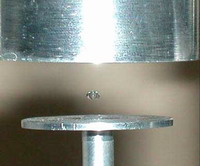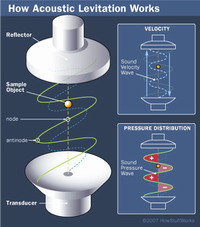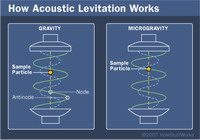Login form
Acoustic Levitation

Unless you travel into the vacuum of space, sound is all around you every day. But most of the time, you probably don't think of it as a physical presence. You hear sounds; you don't touch them. The only exceptions may be loud nightclubs, cars with window-rattling speakers and ultrasound machines that pulverize kidney stones. But even then, you most likely don't think of what you feel as sound itself, but as the vibrations that sound creates in other objects. The idea that something so intangible can lift objects can seem unbelievable, but it's a real phenomenon. Acoustic levitation takes advantage of the properties of sound to cause solids, liquids and heavy gases to float. The process can take place in normal or reduced gravity. In other words, sound can levitate objects on Earth or in gas-filled enclosures in space.
To understand how acoustic levitation works, you first need to know a little about gravity, air and sound. First, gravity is a force that causes objects to attract one another. The simplest way to understand gravity is through Isaac Newton's law of universal gravitation. This law states that every particle in the universe attracts every other particle. The more massive an object is, the more strongly it attracts other objects. The closer objects are, the more strongly they attract each other. An enormous object, like the Earth, easily attracts objects that are close to it, like apples hanging from trees. Scientists haven't decided exactly what causes this attraction, but they believe it exists everywhere in the universe.
Second, air is a fluid that behaves essentially the same way liquids do. Like liquids, air is made of microscopic particles that move in relation to one another. Air also moves like water does -- in fact, some aerodynamic tests take place underwater instead of in the air. The particles in gasses, like the ones that make up air, are simply farther apart and move faster than the particles in liquids.
Third, sound is a vibration that travels through a medium, like a gas, a liquid or a solid object. A sound's source is an object that moves or changes shape very rapidly. For example, if you strike a bell, the bell vibrates in the air. As one side of the bell moves out, it pushes the air molecules next to it, increasing the pressure in that region of the air. This area of higher pressure is a compression. As the side of the bell moves back in, it pulls the molecules apart, creating a lower-pressure region called a rarefaction. The bell then repeats the process, creating a repeating series of compressions and rarefactions. Each repetition is one wavelength of the sound wave.
The sound wave travels as the moving molecules push and pull the molecules around them. Each molecule moves the one next to it in turn. Without this movement of molecules, the sound could not travel, which is why there is no sound in a vacuum. You can watch the following animation to learn more about the basics of sound.
Acoustic levitation uses sound traveling through a fluid -- usually a gas -- to balance the force of gravity. On Earth, this can cause objects and materials to hover unsupported in the air. In space, it can hold objects steady so they don't move or drift.
The process relies on of the properties of sound waves, especially intense sound waves. We'll look at how sound waves become capable of lifting objects in the next section.



